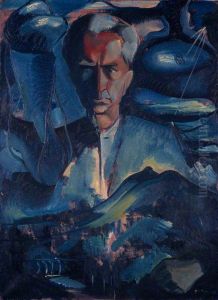William Johnstone Paintings
William Johnstone was a Scottish painter and educator, born on February 18, 1897, in Denholm, Roxburghshire, Scotland. He was one of the pioneers of abstract art in the United Kingdom and became a significant figure in the development of modern art in Scotland.
Johnstone began his artistic training at the Edinburgh College of Art, where he studied from 1919 to 1923. After his studies, he traveled to Paris to continue his education at the Académie de la Grande Chaumière. It was in Paris that Johnstone was exposed to the avant-garde movements of the time, such as Cubism and Surrealism, which would greatly influence his work. He also came into contact with leading artists of the day, including André Lhote, Fernand Léger, and others.
Johnstone initially gained recognition for his landscapes, but his work evolved significantly over his career. By the 1930s, he had begun to develop a more abstract style, characterized by an emphasis on texture and the layering of paint, which he referred to as 'painting by means of growth.' His abstract works often drew inspiration from the Scottish landscape and Celtic mythology, blending a modernist aesthetic with a deep sense of place and history.
During World War II, Johnstone served as a camouflage officer, and this experience further influenced his artistic techniques and themes. After the war, he continued to paint, but also turned to teaching. In 1947, he was appointed as the Head of Painting at the Central School of Arts and Crafts in London. In 1959, Johnstone became Principal of the Central School, a position he held until his retirement in 1960.
Throughout his career, Johnstone exhibited widely and his work is held in the collections of several major institutions, including the Tate Gallery and the Scottish National Gallery of Modern Art. In addition to his painting and teaching, he wrote about art and was involved in the cultural life of Scotland and the UK more broadly.
William Johnstone passed away on March 26, 1981, in London, England. His legacy is that of a pioneering abstract artist who brought a distinctive Scottish voice to the modernist movement and influenced generations of artists through his innovative approach to painting and his dedicated teaching.
